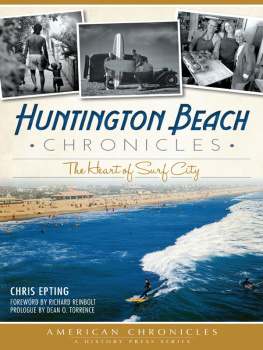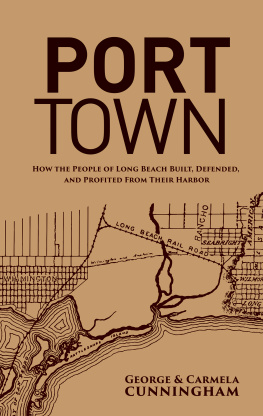

Published by The History Press
Charleston, SC 29403
www.historypress.net
Copyright 2012 by Tim Grobaty
All rights reserved
Images are from the Press-Telegram Archives unless otherwise noted.
First published 2012
e-book edition 2012
ISBN 978.1.61423.407.4
Library of Congress Cataloging-in-Publication Data
Grobaty, Tim.
Long Beach chronicles : from pioneers to the 1933 earthquake / Tim Grobaty.
p. cm.
print edition ISBN 978-1-60949-548-0
1. Long Beach (Calif.)--History. 2. Long Beach (Calif.)--Biography I. Title.
F869.L7G76 2012
979.493--dc23
2012007762
Notice: The information in this book is true and complete to the best of our knowledge. It is offered without guarantee on the part of the author or The History Press. The author and The History Press disclaim all liability in connection with the use of this book.
All rights reserved. No part of this book may be reproduced or transmitted in any form whatsoever without prior written permission from the publisher except in the case of brief quotations embodied in critical articles and reviews.
Contents
Preface
The morgue is a beautiful place.
Im not referring to the place where human corpses are stored, which isnt that grand a place at all, but the place where, at newspapers, history is stored, waiting to be resurrected.
In my thirty-five years at the Press-Telegram, Ive spent hundreds of hours in the morguelater, as journalism grew more polished and civilized (around the time we had to stop drinking and smoking in the newsroom), it was called the libraryscrolling through microfilm, paging through historical volumes and, mostly, going through thousands of packages of clippings and photos.
It was all there, the entire and complete story of the city of Long Beach, from the public lives of mayors down to the kind of fish being caught off Pierpoint Landing. There were, before everything went digital, envelopes with my great-grandmothers name on them. My grandfathers, too. My parents wedding announcement was there, and so was a front-page article about my mothers fatal car crash.
Many of the stories in the morgue were eyewitness accounts from people at the various sites of history, as well as from the reporters themselves who rushed down to the scenes, whether it was to witness the horror of the Empire Day disaster or the overwhelming sight of Henry Fords new Long Beach plant churning out Model A automobiles.
This is where I did virtually all the research for hundreds of columns about Long Beach history over the past three decades. Reporters accounts, which may have subsequently been straightened up and polished by historians who had the luxury of time, may have rushed the facts, typed up immediately after or even during the events. If the reporters made errors, those errors were often passed down through time, copied by later researchers. If they remain in this book, its just as much my fault. I have tried, when facts clashed, to determine which set is the more accurate.
What follows in this book is nothing like a linear or chronological account of the citys history and far less a complete one. It spans, for the most part, the early history of the town, from 1888 to 1933. It hits some major pointsthe 33 quake, for instancebut mostly its a collection of people, places and things that struck me as worth noting: the first phone directory, rules for high school students in the 1920s, laws regarding beachwear and what to plant in front of your yard.
Many of the pieces here are from a collection of fifty columns I wrote during Long Beachs centennial year, 1988; others are taken from an extraordinarily lengthy article about the Press-Telegrams first one hundred years. And still others appeared over the last dozen or so years.
The people who have helped me the most during this span include some great editors: Harold Glicken and Rich Archbold, who are, happily, both still co-workers of mine at the P-T, as well as past editors Jim Robinson and Carolyn Ruskiewicz. Also, when Ive needed outside researchers, Long Beach librarian, historian and author Claudine Burnett has been of great, and Im sure accurate, help.
I am proud and pleased to dedicate this book to Agnes Carroll, Laura Elizabeth Grobaty and my wife, Jane, and our children, Raymond and Hannah.
Part I
The Newspapers and Their City
In 1997, the Press-Telegram celebrated its 100th anniversary, a fairly hazy date that went back to the first days of the Press, as well as to the other papers with which todays Press-Telegram shares its heritage. The following is a brief (though long in terms of newspaper articles) intertwining of the citys early history and the newspapers that covered it.
A copy of a photograph still survives, a century after it was taken, showing four men in front of what was called the Printing Office, a one-story building just a bit more elaborate than a shack that housed the Long Beach Press.
It was all the staff you needed to run a newspaper in a small town of two thousand. Among the men were J.H. Smith and John G. Palmer, the owners and publishers of the Press, which they fired up for the first time in 1897. The other pair, as forgotten as those first few scores of papers the sole machine issued forth, reported and delivered whatever news the seashore village was able to generate.
The road was dirt in front of the Long Beach Press building. From that spot, near the corner of First Street and Pine Avenue, our quartet of pioneer journalists could see and hear thundering surf pound the coast just a few hundred yards away. They could smell the crystalline perfume from the gloriously clean Pacific, feel the salt on their skin.
The sounds were of horses clopping, the traveling squeak of a carriage wheel on its axle, the intermittent clanging from a nearby blacksmiths shop, boys hollering, dogs barking.
It was, perhaps, a bigger deal getting a newspaper one hundred years ago. Thwap! Youd slap it, all rolled up and filled with moment and event, in your palm. Youd unfurl it at home, hunkered in your chair, or on the front steps or at the kitchen table. Youd read bits of it aloud to the family. Listen:
A ferocious school of sharks descended upon William Graves nets last evening and made them unfit for further use by their partly successful attempt to get at the big catch of halibut and barracuda which were within.
F.C. Paine, who has a small ranch at First and Falcon street, dug up a fifteen-pound sweet potato. This is the record for the sweet tubers in this vicinity, though Mr. Paine says he has plenty more as large if not larger than the one unearthed.
FOUND: Bicycle, call at 245 E. First St. and pay for this ad.

The Long Beach Press, with its staff of four, began serving the city of two thousand in 1897 out of its office near First Street and Pine Avenue.
A NEWSPAPER WAR
There wasnt always a citys worth of news in the still-to-boom village as the centurys turn came into view. But there was a citys worth of newspapers. When the Press first hit the streets in September 1897, it joined two other Long Beach papers already in existence.
The Journal
Next page














